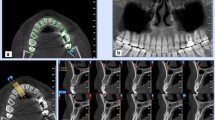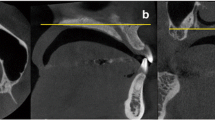Abstract
Objectives
The present study investigated the position and relationship of the maxillary third molars to the maxillary sinus. These molars were detected to have a close relationship with the maxillary sinus based on panoramic images, using cone-beam computed tomography (CBCT).
Methods
This retrospective study evaluated 162 impacted third molars from 100 patients that showed a superimposed relationship between the maxillary sinus and third molars on panoramic images obtained from CBCT. CBCT images were used to assess the horizontal (buccopalatal) and vertical positions of the maxillary sinus relative to the maxillary third molars, proximity of the roots to the sinus, and angulation and depth of the third molars. The associations among the angulation, depth of third molars, and horizontal and vertical positions of the maxillary sinus relative to the third molar findings were examined using Chi square tests.
Results
Based on the winter classification, the most frequent tooth position was vertical (59.9 %), followed by mesioangular (14.2 %), distoangular (9.9 %), and others. Most impacted teeth were at the level between the occlusal and cervical levels of the adjacent second molar. Regarding the relationships of the maxillary third molars with the maxillary sinus examined on CBCT, vertical type III (buccal root related with maxillary sinus) (34 %) and horizontal type 2 (maxillary sinus located between roots) (64.8 %) were seen most frequently.
Conclusions
The relationship between the maxillary sinus and third molar roots should be considered during extraction. When a risk of sinus perforation is predicted in an extraction, a presurgical CBCT examination could be valuable.





Similar content being viewed by others
References
Hashemipour MA, Tahmasbi-Arashlow M, Fahimi-Hanzaei F. Incidence of impacted mandibular and maxillary third molars: a radiographic study in a Southeast Iran population. Med Oral Patol Oral Cir Bucal. 2013;18:e140–5.
Iwai T, Chikumaru H, Shibasaki M, Tohnai I. Safe method of extraction to prevent a deeply-impacted maxillary third molar being displaced into the maxillary sinus. Br J Oral Maxillofac Surg. 2013;51:e75–6.
Kruger E, Thomson WM, Konthasinghe P. Third molar outcomes from age 18 to 26: findings from a population-based New Zealand longitudinal study. Oral Surg Oral Med Oral Pathol Oral Radiol Endod. 2001;92:150–5.
Nakayama K, Nonoyama M, Takaki Y, Kagawa T, Yuasa K, Izumi K, et al. Assessment of the relationship between impacted mandibular third molars and inferior alveolar nerve with dental 3-dimensional computed tomography. J Oral Maxillofac Surg. 2009;67:2587–91.
Lysell L, Rohlin M. A study of indications used for removal of the mandibular third molar. Int J Oral Maxillofac Surg. 1988;17:161–4.
Brauer HU. Unusual complications associated with third molar surgery: a systematic review. Quintessence Int. 2009;40:565–72.
Bouquet A, Coudert JL, Bourgeois D, Mazoyer JF, Bossard D. Contributions of reformatted computed tomography and panoramic radiography in the localization of third molars relative to the maxillary sinus. Oral Surg Oral Med Oral Pathol Oral Radiol Endod. 2004;98:342–7.
Selvi F, Cakarer S, Keskin C, Ozyuvaci H. Delayed removal of a maxillary third molar accidentally displaced into the infratemporal fossa. J Craniofac Surg. 2011;22:1391–3.
Killey H, Kay L. Possible sequelae when a tooth or root is dislodged into the maxillary sinus. Br Dent J. 1964;116:73.
Hirata Y, Kino K, Nagaoka S, Miyamoto R, Yoshimasu H, Amagasa T. A clinical investigation of oro-maxillary sinus-perforation due to tooth extraction. Kokubyo Gakkai Zasshi. 2001;68:249–53.
Jung YH, Nah KS, Cho BH. Correlation of panoramic radiographs and cone beam computed tomography in the assessment of a superimposed relationship between the mandibular canal and impacted third molars. Imaging Sci Dent. 2012;42:121–7.
Kilic C, Kamburoglu K, Yuksel SP, Ozen T. An assessment of the relationship between the maxillary sinus floor and the maxillary posterior teeth root tips using dental cone-beam computerized tomography. Eur J Dent. 2010;4:462–7.
Obayashi N, Ariji Y, Goto M, Izumi M, Naitoh M, Kurita K, et al. CT analyses of the location of the maxillary third molar in relation to panoramic radiographic appearance. Oral Radiol. 2009;25:108–17.
Nakagawa Y, Ishii H, Nomura Y, Watanabe NY, Hoshiba D, Kobayashi K, et al. Third molar position: reliability of panoramic radiography. J Oral Maxillofac Surg. 2007;65:1303–8.
Şekerci AE, Şişman Y. Comparison between panoramic radiography and cone-beam computed tomography findings for assessment of the relationship between impacted mandibular third molars and the mandibular canal. Oral Radiol. 2014;30:170–8.
Hazza’a AM, Albashaireh Z, Bataineh AB. The relationship of the inferior dental canal to the roots of impacted mandibular third molars in a Jordanian population. J Contemp Dent Pract. 2006;7:71–8.
de Melo Albert DG, Gomes ACA, do Egito Vasconcelos BC, de E Silva ED, Holanda GZ. Comparison of orthopantomographs and conventional tomography images for assessing the relationship between impacted lower third molars and the mandibular canal. J Oral Maxillofac Surg. 2006;64:1030–7.
de Carvalho RWF, de Araújo Filho RCA, do Egito Vasconcelos BC. Assessment of factors associated with surgical difficulty during removal of impacted maxillary third molars. J Oral Maxillofac Surg. 2013;71:839–45.
Lim AAT, Wong CW, Allen JC. Maxillary third molar: patterns of impaction and their relation to oroantral perforation. J Oral Maxillofac Surg. 2012;70:1035–9.
Winter G. Principles of exodontias as applied to the impacted third molars: a complete treatise on the operative technic with clinical diagnoses and radiographic interpretations. 1st ed. St. Louis: American Medical Books; 1926. p. 21–58.
Ventä I, Turtola L, Ylipaavalniemi P. Radiographic follow-up of impacted third molars from age 20 to 32 years. Int J Oral Maxillofac Surg. 2001;30:54–7.
Kurihara N, Sasano T, Iikubo M, Kobayashi A, Shimeno Y, Abue M, et al. A diagnostic study on the criteria for extraction of third molars. Part 2: temporal change in third molar positions for the past 21 years (in Japanese). Jpn J Oral Diag Oral Med. 2003;16:32–40.
Author information
Authors and Affiliations
Corresponding author
Ethics declarations
Conflict of interest
Omer Demirtas and Abubekir Harorli declare that they have no conflict of interest.
Human rights statements and informed consent
All procedures followed were in accordance with the ethical standards of the responsible committee on human experimentation (institutional and national) and with the Helsinki Declaration of 1964 and later versions. Informed consent was obtained from all patients for being included in the study.
Rights and permissions
About this article
Cite this article
Demirtas, O., Harorli, A. Evaluation of the maxillary third molar position and its relationship with the maxillary sinus: a CBCT study. Oral Radiol 32, 173–179 (2016). https://doi.org/10.1007/s11282-015-0228-2
Received:
Accepted:
Published:
Issue Date:
DOI: https://doi.org/10.1007/s11282-015-0228-2




